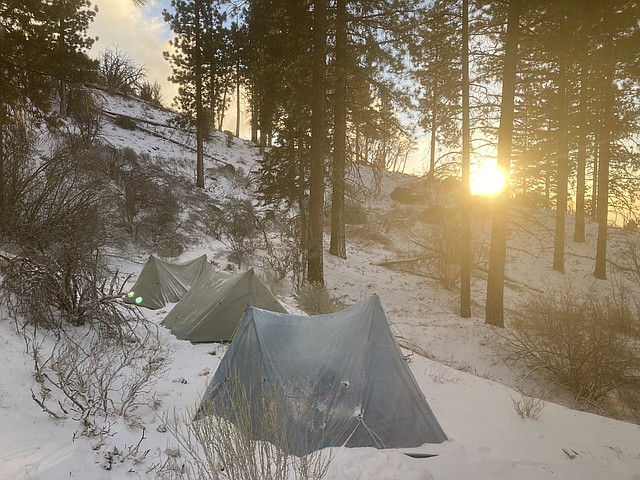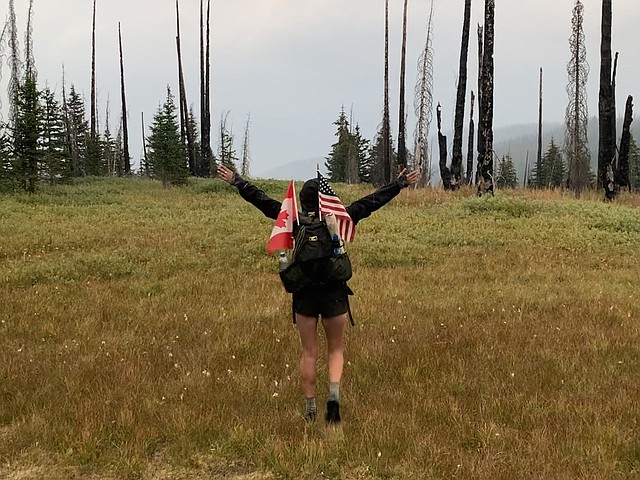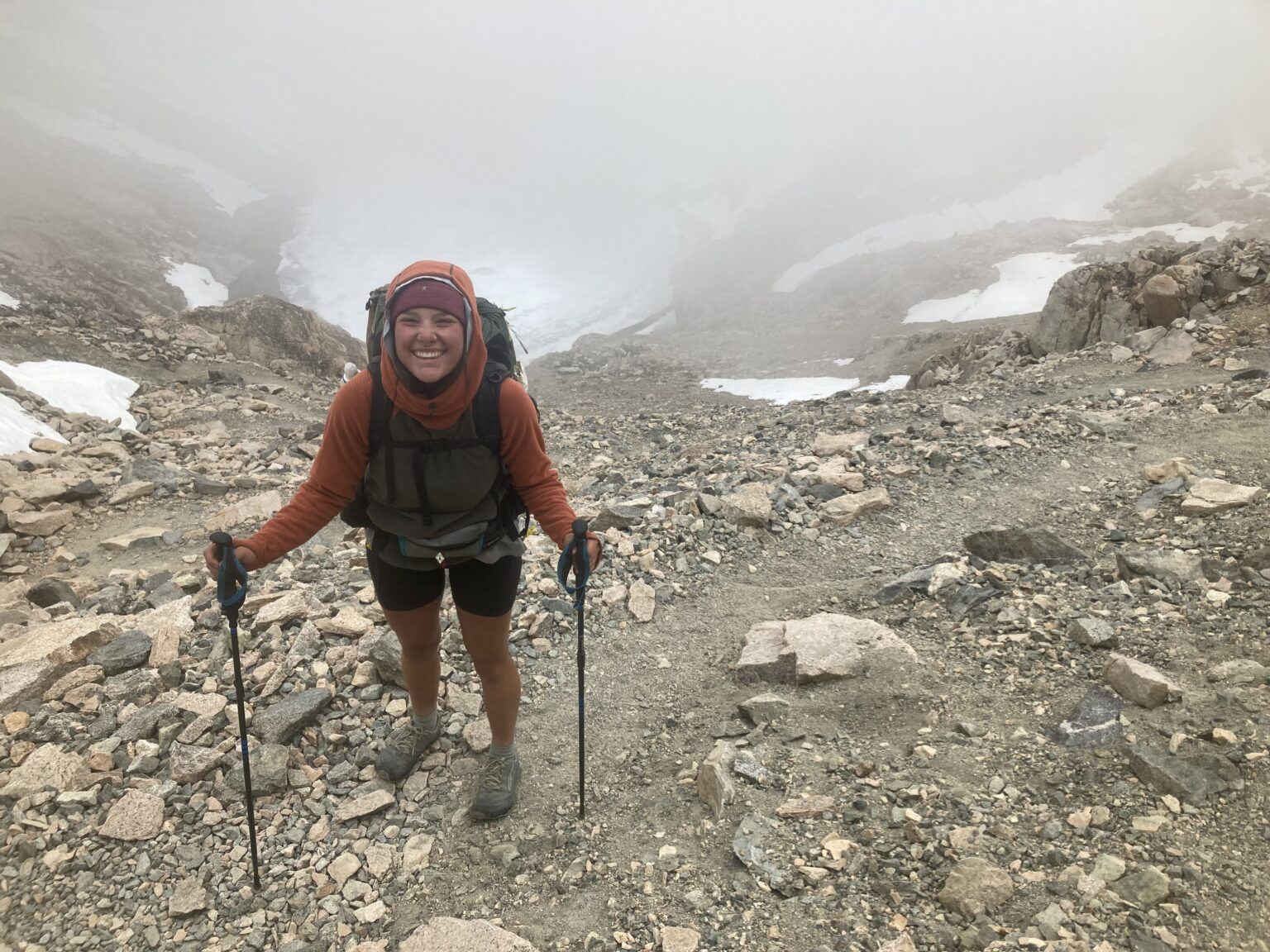Willow Gebhard knew she would not finish the Pacific Crest Trail (PCT) after rounding a corner in the North Cascades 36 miles from the Canadian border.
“It looked like an atomic bomb had gone off in the distance — a pyro-cumulous mushroom cloud,” she recalled recently.
Lightning-caused fires in the Pasayten Wilderness in August conspired to close the 2,650-mile PCT just a day’s hike to the border.
Get used to it, as climatologists say the idea of hiking the Pacific Crest Trail is rapidly changing. A 2022 story in the PCT Association magazine explains how rising temperatures, fire and drought might alter the thru-hiking experience for coming generations.
Once considered an epic wilderness adventure, those attempting the renowned trek from Mexico to Canada now regularly face trail closures, detours and hazardous smoke.
The conditions did not discourage Gebhard, of Alger, to set off on her 19th birthday on April 4 from Campo, California. She had dreamed of this soul-searching journey since childhood. Her thru-hiking experience began at age 16 when completing the 486-mile Colorado Trail.
Gebhard covered much of California and Oregon while avoiding new fire-related trail closures. The solo hiker safely passed through one section in Oregon three hours before authorities closed it.
 Willow Gebhard of Alger smiles atop Half Dome in Yosemite National Park. She did the side trip up the cables to the famous rock while hiking the Pacific Crest Trail this year. (Photo courtesy of Ky Storey)
Willow Gebhard of Alger smiles atop Half Dome in Yosemite National Park. She did the side trip up the cables to the famous rock while hiking the Pacific Crest Trail this year. (Photo courtesy of Ky Storey)
But her hopes of avoiding fire altogether were reduced to prayers in late August when reaching the Rainy Pass trailhead off State Route 20. U.S. Forest Service rangers posted fire alerts at the start of the PCT’s final stretch.
By then, Gebhard had been hiking in Washington with five others. All had contracted norovirus, a contagious stomach disease often spread on the trails.
The 24-hour virus was the least of their concerns once they saw the mushroom cloud seven miles from Hart’s Pass. The group kept going before meeting 20 hikers two miles later where the journey ended.
“Everyone was distraught, crying and looked out of it,” Gebhard said.
The hikers had carried champagne for a border celebration at Monument 78. Instead, they opened the bottles that night to commemorate how close they got to the finish line.
Still, it felt incomplete. Gebhard called her father on a satellite phone to retrieve them at Hart’s Pass. Her group reconvened at the family’s Mazama cabin to consider their next move.
“All of a sudden it’s your last night [on the trail],” Gebhard said. “It is something we all worked so hard for. I had never worked so hard for anything.”
She was not ready to leave the trail after four-and-a-half months of navigating high desert terrain, rugged Sierra peaks and long spells of loneliness. “To be so close was absolutely devastating,” said Gebhard, a Sehome High School and Whatcom Community College alum.
All the planning in the world cannot overcome a challenging environment as the signs of human-caused climate change become more pronounced.
Everyone in the wilderness feels it. Fire scars leave powerful, lasting imprints of dreary, blackened landscapes devoid of life. Forest regeneration might not return the area to its pre-fire state, scientists report.
Gebhard spent days walking through an 85-mile burn section near Lassen Volcanic National Park in northern California. She crossed ashen footpaths with singed trees – the remains of the 2021 Dixie Fire, which is California’s second-largest wildfire in history.
Intense West Coast wildfires subverted Gebhard’s ideal of covering every step of the PCT in a continuous line. A 70-mile stretch near Mount Jefferson in central Oregon had been closed for two years because of a fire.
But just as the border closed, the Mount Jefferson Wilderness trail reopened. Gebhard and friends traveled south to complete the section and get more time on the trail together.
 Willow Gebhard, 19, of Alger camped in the snow in the San Bernardino Mountains in Southern California during the early months of a thru-hike on the Pacific Crest Trail. (Photo courtesy of Willow Gebhard)
Willow Gebhard, 19, of Alger camped in the snow in the San Bernardino Mountains in Southern California during the early months of a thru-hike on the Pacific Crest Trail. (Photo courtesy of Willow Gebhard)
Then more good news arrived when the group reached Timberline Lodge on Mount Hood. The Pacific Crest Trail Association, which manages the PCT, opened an alternative route to the Canadian border.
The hikers returned to Mazama to resupply and find their way to the new, remote trailhead. They hiked 22 miles to the border on Sept. 12.
Gebhard said a lightning storm magically lit the sky as the hikers let out celebratory screams. They heard wolves howling in the distance and later found the pack near their campsite. The hikers also encountered two bears.
“Ultimately, it was the experience that needed to happen,” Gebhard said of how reaching the border gave her closure.
The PCT became a national scenic trail 42 years after Bellingham’s Catherine Montgomery, an educator and avid hiker, proposed the idea of a trail connecting the three West Coast states. About 200 hikers annually attempt the journey, most starting at the Mexican border in spring. Although the exact number of finishers is unknown, the PCT Association says more than 9,000 have done it.
Add Gebhard to the list of a journey that changed her in ways she never imagined.
“I went into the trail with a rigid way of thinking,” Gebhard said. “It was good to have this really devastating blow and learn how to accept a different reality to what I thought would happen.”
 Willow Gebhard of Alger celebrates with American and Canadian flags on Sept. 12 after reaching the border using an alternate route for the Pacific Crest Trail. “We were the only people out there,” she recalled. (Photo courtesy of Evan Arnold)
Willow Gebhard of Alger celebrates with American and Canadian flags on Sept. 12 after reaching the border using an alternate route for the Pacific Crest Trail. “We were the only people out there,” she recalled. (Photo courtesy of Evan Arnold)
Unspoken trail rules can lead to judgment in a subculture like thru-hiking. Hikers who did not complete the PCT in a straight line — south to north, or vice versa — were not considered legitimate. Gebhard hopes people start accepting the strategy of “flip-flopping,” or hiking sections in whatever direction works best under fast-changing conditions.
Gebhard said once she relaxed the rules, “I wasn’t worried about thru-hiking the right way, but doing it my way.”
Along the way, she summited 14,505-foot Mount Whitney — the highest U.S. peak outside of Alaska — as well as the famed Half Dome in Yosemite National Park.
Gebhard plans to complete the 800-mile Arizona Trail before entering Western Washington University in the fall to work toward a teacher’s credential.
But don’t expect her to settle in. Gebhard has the 1,200-mile Pacific Northwest Trail on the horizon. It starts in Glacier National Park in Montana and ends at a beach in Olympic National Park in Port Angeles.
“I’m just getting started,” she said.
Elliott Almond’s outdoor column appears monthly. Email: elliottalmond4@gmail.com.




